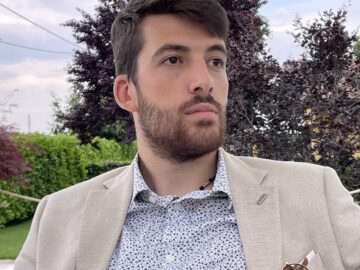Umberto Mosca
Ph.D. Student
Politecnico di Torino,
Control and Computer Engineering Department
Who i am
Currently Ph.D. student in Artificial Intelligence at the Department of Control and Computer Engineering of Politecnico di Torino. My intent is to thoroughly explore sleep study using data acquired using simple wearable devices and analyse them using AI models.
I chose Politecnico di Torino for my whole university education, where I graduated with a Master’s degree in Biomedical Engineering. It was thanks to my master’s thesis, entitled “Automatic classification of REM Sleep Behaviour Disorder exploiting Heart Rate Variability and Electromyography”, that I became passionate about the scientific research field, focusing my attention on the sleep study.
Scientific interest
The scientific community recognises the importance of assessing this physiological state. In fact, pathologies capable of altering sleep quality and, in some cases, prodromal to neurodegenerative diseases may be concealed during sleep.
To date, an accurate sleep study requires undergoing polysomnography. It involves recording various physiological signals (electroencephalogram EEG, electromyogram EMG, electrocardiogram ECG, electrooculogram EOG) throughout the patient’s nocturnal sleep. Due to the criticalities just described, it is not possible to carry out sleep studies on a large scale. Consequently, this limits the possibility of detecting certain pathologies in advance of symptom evidence.
Research goal
The goal I would like to pursue is to use AI algorithms to make the sleep study more accessible. Several possible approaches come to my mind. For example, one could consider developing AI algorithms that exploit machine learning (ML) or, if feasible, deep learning (DL) to assist healthcare professionals in reporting polysomnographic examinations. A second way is to train ML or DL models based on signals recorded with easy-to-use wearable sensors (e.g. chest strap, wrist-mounted optical reader, IMU, etc.) in order to obtain an initial classification of the subject examined. It would not provide a diagnosis, but can serve as an index to determine whether the subject deserves to be subjected to specific examinations. In this way, costs would be drastically cut and a screening campaign could be considered for the population most at risk of developing neurodegenerative diseases.
The topic just described has been the subject of much scientific research in recent years. In fact, approaches can be found in the published literature that attempt to perform automatic sleep staging or to investigate features calculated from polysomnographic signals that may be indicative of a specific pathology.
My master’s thesis work aimed to fulfil precisely this purpose. Indeed, it focuses on a REM sleep parasomnia called REM sleep behaviour disorder (RBD) with the important feature to have a conversion rate to synucleinopathies (e.g. Parkinson’s disease, dementia with Lewy bodies…) at 14 years of age greater than 85%. The diagnosis of synucleinopathies, and especially of Parkinson’s disease, in almost all cases occurs on symptom evidence. By this time, the disease is at an advanced stage in which the only available therapies are symptomatic.
Research application purpose
The RBD diagnosis makes it possible to identify patients at an early stage who, with a very high probability, will develop synucleinopathy within the next decade. This would make it possible to respond with early and, consequently, more effective therapy; it would also open up the possibility of testing neuroprotective drugs at an extremely early stage, since at the onset of symptoms neurodegeneration is already extremely advanced.

